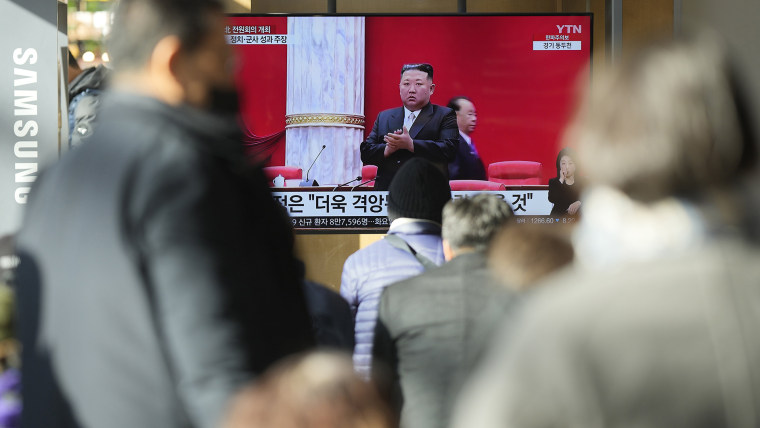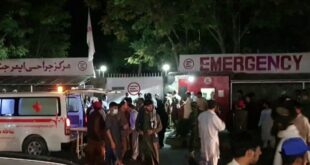[ad_1]
SEOUL, South Korea — North Korea fired three short-range ballistic missiles toward its eastern waters in its latest weapons display on Saturday, a day after rival South Korea launched a solid-fueled rocket as part of its efforts to build a space-based surveillance capability to better monitor the North.
Tensions between the rival Koreas rose earlier this week when South Korea accused North Korea of flying five drones across the rivals’ tense border for the first time in five years and responded by sending its own drones toward the North.
South Korea’s Joint Chiefs of Staff said in a statement it detected the three launches from an inland area south of Pyongyang, the North’s capital, on Saturday morning. It said the three missiles traveled 220 miles before landing in the waters between the Korean Peninsula and Japan. The estimated range suggests the missiles tested target South Korea.
The Joint Chiefs of Staff called the launches “a grave provocation” that undermines international peace. It said South Korea closely monitors North Korean moves in coordination with the United States and maintains a readiness to “overwhelmingly” deter any provocation by North Korea.
The U.S. Indo-Pacific Command said the launches highlight “the destabilizing impact” of North Korea’s unlawful weapons programs and that the U.S. commitments to the defense of South Korea and Japan “remain ironclad.” Earlier Saturday, Japan’s Defense Ministry also reported suspected ballistic missile firings by North Korea.
It was North Korea’s first missile launch in eight days and came five days after South Korea said it detected the North Korean drones, all presumed to be small surveillance drones, south of the border.
South Korea’s military on Monday scrambled warplanes and helicopters, but they failed to shoot down any of the North Korean drones before they flew back home or vanished from South Korean radar. One of the North Korean drones traveled as far as northern Seoul. That caused security jitters among many people in the South, for which the military offered a rare public apology Tuesday.
South Korea still flew three of its surveillance drones across the border on Monday in an unusual tit-for-tat step against a North Korean provocation. South Korea on Thursday staged large-scale military drills to simulate shooting down drones.
South Korean President Yoon Suk Yeol has called for boosting his country’s air defense network and vowed to sternly deal with provocations by North Korea.
Since taking office in May, Yoon’s government has expanded regular military drills with the U.S. in the face of increasing North Korean nuclear threats. North Korea has called such drills between its rivals an invasion rehearsal and argued its recent missile tests were a response to them. But some experts say North Korea is using the South Korea-U.S. training as a pretext to modernize its arsenal and increase its leverage in future dealings with the U.S.
Before Saturday’s launches, North Korea had already test-fired more than 70 missiles this year. Many of them were nuclear-capable weapons designed to attack the U.S. mainland and its allies South Korea and Japan.
On Friday, South Korea launched a solid-fueled rocket, a type of a space launch vehicle that it plans to use to put its first spy satellite into orbit in coming years.
In March, South Korea conducted its first successful launch of a solid-fuel rocket, and defense officials said Friday’s launch was a follow-up test to the earlier launch. Friday’s unannounced launch triggered a brief public scare of a UFO appearance or a North Korean missile firing in South Korea.
South Korea currently has no military reconnaissance satellites of its own and depends on U.S. spy satellites to monitor strategic facilities in North Korea.
North Korea is also pushing to acquire its first military surveillance satellite. Earlier this month, North Korea said it used two old missiles as space launch vehicles to test a camera and other systems needed for a spy satellite and later released low-resolution satellite photos showing South Korean cities.
Some South Korean experts said the North Korean satellite imagery was too crude for military reconnaissance purposes and that they are likely a disguised test of North Korea’s missile technology. Infuriated over such an assessment, Kim Yo Jong, the powerful sister of North Korean leader Kim Jong Un, issued crude insults against unidentified South Korean experts. She also dismissed some outside doubts over North Korea’s intercontinental ballistic missile technology and threatened to conduct a full-range, standard-trajectory ICBM test.
This week, North Korea is under a major ruling party meeting in Pyongyang to review past policies and new policy goals for 2023. It’s highly unusual for North Korea to test-launch a missile when it holds a key meeting.
In an indication that the plenary meeting of the Workers’ Party was being wrapped up, the North’s state media reported Saturday that its powerful Politburo decided to complete the draft resolution of the plenary meeting.
ADVERTISEMENT
Some observers said North Korea will likely publish details of the meeting on Sunday, which would carry Kim Jong Un’s vows to expand his nuclear arsenal and introduce sophisticated weapons in the name of dealing with what he calls U.S. hostility.
 Latest Breaking News Online News Portal
Latest Breaking News Online News Portal





